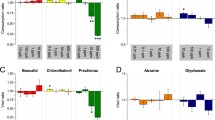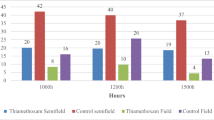Abstract
To investigate honeybee foraging responses to toxic nectar, honey was collected from Apis cerana colonies in the Yaoan county of Yunnan Province, China, during June, when flowers of Tripterygium hypoglaucum were the main nectar source available. Pollen analysis confirmed the origin of the honey, and high-performance liquid chromatography showed the prominent component triptolide to be present at a concentration of 0.61 μg/g ± 0.11 SD. In cage tests that used young adult worker bees, significantly more of those provided with a diet of T. hypoglaucum honey mixed with sugar powder (1:1) died within 6 d (68.3%) compared to control groups provided with normal honey mixed with sugar powder (15.8%). Honeybees were trained to visit feeders that contained honey of T. hypoglaucum (toxic honey) as the test group and honey of Vicia sativa or Elsholtzia ciliata as control groups (all honeys diluted 1:3 with water). Bees preferred the feeders with normal honey to those with toxic honey, as shown by significantly higher visiting frequencies and longer imbibition times. However, when the feeder of normal honey was removed, leaving only honey of T. hypoglaucum, the foraging bees returned to the toxic honey after a few seconds of hesitation, and both visiting frequency and imbibition time increased to values previously recorded for normal honey. Toxic honey thus became acceptable to the bees in the absence of other nectar sources.



Similar content being viewed by others
References
Adler, L. S. 2000. The ecological significance of toxic nectar. Oikos 91:409–420.
Baker, H. G., and Baker, I. 1982. Chemical constituents of nectar in relation to pollination mechanisms and phylogeny, Biochemical Aspects of Evolutionary Biology. pp. 131–171, in M. H. Nitecki (ed.). University of Chicago Press, Chicago.
Brinker, A. M., and Raskin, I. 2005. Determination of triptolide in root extracts of Tripterygium wilfordii by solid-phase extraction and reverse-phase high-performance liquid chromatography. J. Chromatogr. A 1070:65–70.
Brinker, A. M., Ma, J., Lipsky, P. E., and Raskin, I. 2007. Medicinal chemistry and pharmacology of genus Tripterygium (Celastraceae). Phytochemistry 68:732–766.
Detzel, A., and Wink, M. 1993. Attraction, deterrence or intoxication of bees (Apis mellifera) by plant allelochemicals. Chemoecology 4:8–18.
Gegear, R. J., Manson, J. S., and Thomson, J. D. 2007. Ecological context influences pollinator deterrence by alkaloids in floral nectar. Ecol. Lett. 10:375–382.
Hagler, J. R., and Buchmann, S. L. 1993. Honey bee (Hymenoptera: Apidae) foraging responses to phenolic-rich nectars. J. Kans. Entomol. Soc. 66:223–230.
Kessler, D., and Baldwin, I. T. 2006. Making sense of nectar scents: the effects of nectar secondary metabolites on floral visitors of Nicotiana attenuata. Plant J. 49:840–854.
Laska, M., Galizia, C. G., Giurfa, M., and Menzel, R. 1999. Olfactory discrimination ability and odor structure–activity relationships in honeybees. Chem. Senses 24:429–438.
Lindauer, M. 1948. Uber die Einwirkung von Duft—und Geschmackstoffen sowie anderer Faktoren auf die Tänze der Bienen. Z. Vergleich. Physiol. 31:348–412.
Liu, F., Chen, J., Chai, J., Zhang, X., Bai, X., He, D., and Roubik, D. W. 2007. Adaptive functions of defensive plant phenolics and a non-linear bee response to nectar components. Funct. Ecol. 21:96–100.
Liu, F., He, J., and Fu, W. 2005. Highly controlled nest homeostasis of honey bees helps deactivate phenolics in nectar. Naturwissenschaften 92:297–299.
London-Shafir, I., Shafir, S., and Eisikowitch, D. 2003. Amygdalin in almond nectar and pollen—facts and possible roles. Plant Syst. Evol. 238:87–95.
Masters, A. R. 1991. Dual role of pyrrolizidine alkaloids in nectar. J. Chem. Ecol. 17:195–205.
Naef, R., Jaquier, A., Velluz, A., and Bachofen, B. 2004. From the linden flower to linden honey—volatile constituents of linden nectar, the extract of bee-stomach and ripe honey. Chem. Biodivers. 1:1870–1879.
Nicolson, S. W., and Thornburg, R. T. 2007. Nectar chemistry, Nectaries and Nectar. pp. 215–264, in S.W. Nicolson, M. Nepi, and E. Pacini (eds.). Springer, Dordrecht.
Pham-Delegue, M. H., Blight, M. M., Kerguelen, V., Le Metayer, M., Marion-Poll, F., Sandoz, J. C., and Wadhams, L. J. 1997. Discrimination of oilseed rape volatiles by the honeybee: combined chemical and biological approaches. Entomol. Exp. Appl. 83:87–92.
Qiu, D., and Kao, P. N. 2003. Immunosuppressive and anti-inflammatory mechanisms of triptolide, the principal active diterpenoid from the Chinese Tripterygium wilfordii Hook. f. Drugs R&D 4:1–18.
Raguso, R. A. 2004. Why are some floral nectars scented? Ecology 85:1486–1494.
Raguso, R. A., and Pichersky, E. 1999. A day in the life of a linalool molecule: chemical communication in a plant–pollinator system. Part 1. Linalool biosynthesis in flowering plants. Plant Species Biol. 14:95–120.
Rhoades, D. F., and Bergdahl, J. C. 1981. Adaptive significance of toxic nectar. Am. Nat. 117:798–803.
Singaravelan, N., Inbar, M., Ne'eman, G., Distl, M., Wink, M., and Izhaki, I. 2006. The effects of nectar-nicotine on colony fitness of caged honeybees. J. Chem. Ecol. 32:49–58.
Singaravelan, N., Nee'man, G., Inbar, M., and Izhaki, I. 2005. Feeding responses of free-flying honeybees to secondary compounds mimicking floral nectars. J. Chem. Ecol. 31:2791–2804.
Sokal, R. R., and Rohlf, F. J. 1995. Biometry: the principles and practice of statistics in biological research. 3rd edn.W. H. Freeman, New York.
Statsoft. 2006. STATISTICA, version 7.1. Available at: http://www.statsoft.com.
Stephenson, A. G. 1982. Iridoid glycosides in the nectar of Catalpa speciosa are unpalatable to nectar thieves. J. Chem. Ecol. 8:1025–1034.
Visscher, P. K., and Seeley, T. D. 1982. Foraging strategy of honeybee colonies in a temperate deciduous forest. Ecology 63:1790–1801.
Zhen, Q. S., Ye, X., and Wei, Z. J. 1995. Recent progress in research on Tripterygium: a male antifertility plant. Contraception 51:121–129.
Acknowledgements
Financial support was granted by the Xishuangbanna Tropical Botanical Garden, Chinese Academy of Science and the Yunnan Agricultural University of China.
Author information
Authors and Affiliations
Corresponding author
Rights and permissions
About this article
Cite this article
Tan, K., Guo, Y.H., Nicolson, S.W. et al. Honeybee (Apis cerana) Foraging Responses to the Toxic Honey of Tripterygium hypoglaucum (Celastraceae): Changing Threshold of Nectar Acceptability. J Chem Ecol 33, 2209–2217 (2007). https://doi.org/10.1007/s10886-007-9384-0
Received:
Revised:
Accepted:
Published:
Issue Date:
DOI: https://doi.org/10.1007/s10886-007-9384-0




